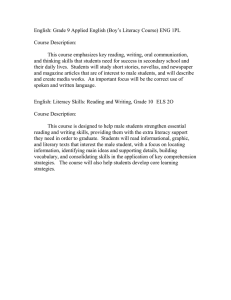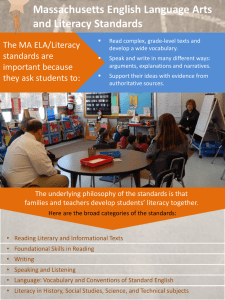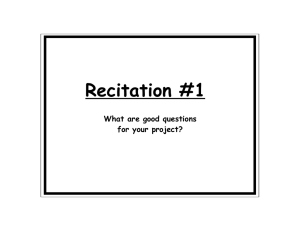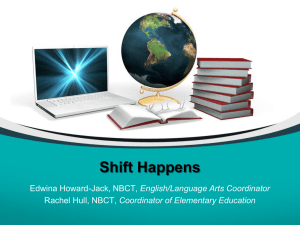Longman Keystone D Pacing Guide Course Title: English 2 through
advertisement
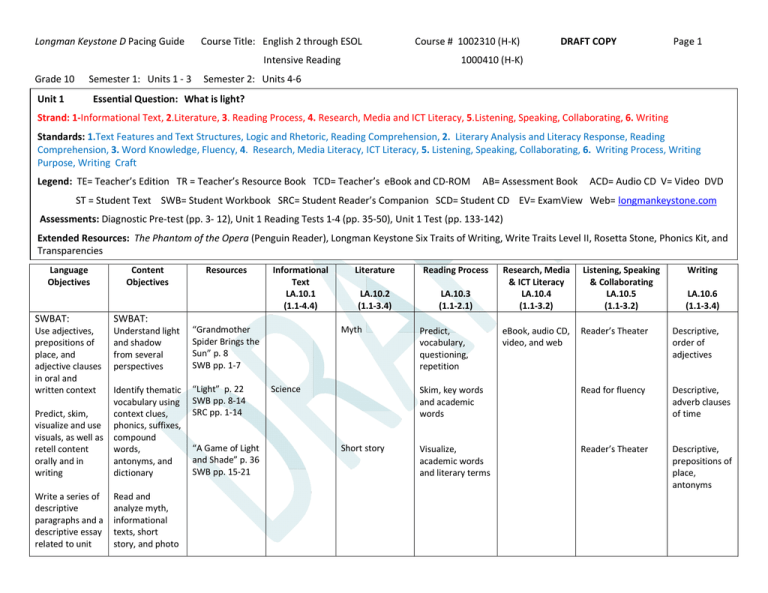
Longman Keystone D Pacing Guide Course Title: English 2 through ESOL Course # 1002310 (H‐K) DRAFT COPY Page 1 Intensive Reading 1000410 (H‐K) Grade 10 Semester 1: Units 1 ‐ 3 Semester 2: Units 4‐6 Unit 1 Essential Question: What is light? Strand: 1‐Informational Text, 2.Literature, 3. Reading Process, 4. Research, Media and ICT Literacy, 5.Listening, Speaking, Collaborating, 6. Writing Standards: 1.Text Features and Text Structures, Logic and Rhetoric, Reading Comprehension, 2. Literary Analysis and Literacy Response, Reading Comprehension, 3. Word Knowledge, Fluency, 4. Research, Media Literacy, ICT Literacy, 5. Listening, Speaking, Collaborating, 6. Writing Process, Writing Purpose, Writing Craft Legend: TE= Teacher’s Edition TR = Teacher’s Resource Book TCD= Teacher’s eBook and CD‐ROM AB= Assessment Book ACD= Audio CD V= Video DVD ST = Student Text SWB= Student Workbook SRC= Student Reader’s Companion SCD= Student CD EV= ExamView Web= longmankeystone.com Assessments: Diagnostic Pre‐test (pp. 3‐ 12), Unit 1 Reading Tests 1‐4 (pp. 35‐50), Unit 1 Test (pp. 133‐142) Extended Resources: The Phantom of the Opera (Penguin Reader), Longman Keystone Six Traits of Writing, Write Traits Level II, Rosetta Stone, Phonics Kit, and Transparencies Language Objectives Content Objectives SWBAT: SWBAT: Use adjectives, prepositions of place, and adjective clauses in oral and written context Understand light and shadow from several perspectives Identify thematic vocabulary using Predict, skim, context clues, visualize and use phonics, suffixes, visuals, as well as compound retell content words, orally and in antonyms, and writing dictionary Write a series of descriptive paragraphs and a descriptive essay related to unit Read and analyze myth, informational texts, short story, and photo Resources Informational Text LA.10.1 (1.1‐4.4) “Grandmother Spider Brings the Sun” p. 8 SWB pp. 1‐7 “Light” p. 22 SWB pp. 8‐14 SRC pp. 1‐14 “A Game of Light and Shade” p. 36 SWB pp. 15‐21 Literature Reading Process LA.10.2 (1.1‐3.4) LA.10.3 (1.1‐2.1) Myth Science Short story Predict, vocabulary, questioning, repetition Research, Media & ICT Literacy LA.10.4 (1.1‐3.2) Listening, Speaking & Collaborating LA.10.5 (1.1‐3.2) eBook, audio CD, Reader’s Theater video, and web Writing LA.10.6 (1.1‐3.4) Descriptive, order of adjectives Skim, key words and academic words Read for fluency Descriptive, adverb clauses of time Visualize, academic words and literary terms Reader’s Theater Descriptive, prepositions of place, antonyms Longman Keystone D Pacing Guide Course Title: English 2 through ESOL Course # 1002310 (H‐K) DRAFT COPY Page 2 Intensive Reading 1000410 (H‐K) Grade 10 Semester 1: Units 1 ‐ 3 Semester 2: Units 4‐6 Language Objectives Content Objectives Resources theme Explain (orally or in writing) the unit theme through the use of video, text visuals, website links, and artwork essay as they from The Eye of relate to the unit Conscience theme p. 48 SWB pp. 22‐31 Define and use SRC pp. 15‐28 literary terms: onomatopoeia, repetition, imagery, setting Create oral and written projects and presentations using content obtained from media resources and Information Communication Technologies (ICT) View video, text visuals, website links, and artwork to understand the unit theme Employ inquiry‐ based research to evaluate information, construct new understandings, and communicate findings Informational Text LA.10.1 (1.1‐4.4) Social Studies Literature Reading Process LA.10.2 (1.1‐3.4) LA.10.3 (1.1‐2.1) Use visuals, author’s purpose Research, Media & ICT Literacy LA.10.4 (1.1‐3.2) Listening, Speaking & Collaborating LA.10.5 (1.1‐3.2) Read for fluency Writing LA.10.6 (1.1‐3.4) Identify and nonidentity adjective clauses Longman Keystone D Pacing Guide Course Title: English 2 through ESOL Course # 1002310 (H‐K) DRAFT COPY Page 3 Intensive Reading 1000410 (H‐K) Grade 10 Semester 1: Units 1 ‐ 3 Semester 2: Units 4‐6 Unit 2 Essential Question: How are growth and change related? Strand: 1‐Informational Text, 2.Literature, 3. Reading Process, 4. Research, Media and ICT Literacy, 5.Listening, Speaking, Collaborating, 6. Writing Standards: 1.Text Features and Text Structures, Logic and Rhetoric, Reading Comprehension, 2. Literary Analysis and Literacy Response, Reading Comprehension, 3. Word Knowledge, Fluency, 4. Research, Media Literacy, ICT Literacy, 5. Listening, Speaking, Collaborating, 6. Writing Process, Writing Purpose, Writing Craft Legend: TE= Teacher’s Edition TR = Teacher’s Resource Book TCD= Teacher’s eBook and CD‐ROM AB= Assessment Book ACD= Audio CD V= Video DVD ST = Student Text SWB= Student Workbook SRC= Student Reader’s Companion SCD= Student CD EV= ExamView Web= longmankeystone.com Assessments: Unit 2 Reading Tests 1‐4 (pp. 51‐66), Unit 2 Test (pp. 143‐152) Extended Resources: Martin Luther King (Penguin Reader), Longman Keystone Six Traits of Writing, Write Traits Level II, Rosetta Stone, Phonics Kit, and Transparencies Language Objectives Content Objectives Resources Informational Text LA.10.1 (1.1‐4.4) Literature Reading Process LA.10.2 (1.1‐3.4) LA.10.3 (1.1‐2.1) SWBAT: SWBAT: Use sequence words, factual and unreal conditional sentences, simple past vs. present perfect tenses, and ‘have to’ orally and in writing Understand how people and things grow and change from several perspectives “How Seeds and Plants Grow” p. 76 SWB pp. 33‐39 SRC pp. 29‐36 Identify thematic vocabulary using related words, spelling patterns, idioms, and internet, and thesaurus “Two Brothers and the Pumpkin Seeds” p. 78 SWB pp. 33‐39 Folktale Recognize author’s purpose Roll of Thunder, Hear My Cry p. 88 SWB pp. 40‐46 Novel excerpt Literary terms, academic words, compare and contrast, question and answer Identify and use compare and contrast vocabulary, and make inferences orally and in writing Read and analyze informational text, folktale, Science Research, Media & ICT Literacy LA.10.4 (1.1‐3.2) Listening, Speaking & Collaborating LA.10.5 (1.1‐3.2) Use of visuals, key eBook, audio CD, Describe a process , words, academic video, website read for fluency words, recognize sequence Reader’s Theater Writing LA.10.6 (1.1‐3.4) Sequence words, story writing Conditional sentences, narrative writing Longman Keystone D Pacing Guide Course Title: English 2 through ESOL Course # 1002310 (H‐K) DRAFT COPY Page 4 Intensive Reading 1000410 (H‐K) Grade 10 Semester 1: Units 1 ‐ 3 Semester 2: Units 4‐6 Language Objectives Content Objectives Write a series of narrative paragraphs and a fictional narrative novel excerpt, short story as well as chart and graph as they relate to theme Explain (orally or in writing) the unit theme through the use of video, text visuals, website links, and artwork Define and use literary terms: point of view, plot, conflict, characterization, dialogue Create oral and written projects and presentations using content obtained from media resources and Information Communication Technologies (ICT) View video, text visuals, website links, and artwork to understand the unit theme Employ inquiry‐ based research to evaluate information, construct new understandings, and communicate findings Resources “Migration Patterns” p. 102 SWB pp. 47‐53 SRC pp. 37‐48 “Abuela Invents the Zero” p. 114 SWB pp. 54‐63 Informational Text LA.10.1 (1.1‐4.4) Literature Reading Process LA.10.2 (1.1‐3.4) LA.10.3 (1.1‐2.1) Social Studies Scan, key words, academic words Short story Literary terms, academic words, make inferences Research, Media & ICT Literacy LA.10.4 (1.1‐3.2) Listening, Speaking & Collaborating LA.10.5 (1.1‐3.2) Writing Charts and graphs Retelling Simple past and present perfect, personal letter writing Reader’s Theater, discussion Have to + verb, personal narrative, organization, word choice, and conventions, edit, and proof read LA.10.6 (1.1‐3.4) Longman Keystone D Pacing Guide Course Title: English 2 through ESOL Course # 1002310 (H‐K) DRAFT COPY Page 5 Intensive Reading 1000410 (H‐K) Grade 10 Semester 1: Units 1 ‐ 3 Semester 2: Units 4‐6 Unit 3 Essential Question: How can we tell what’s right? Strand: 1‐Informational Text, 2.Literature, 3. Reading Process, 4. Research, Media and ICT Literacy, 5.Listening, Speaking, Collaborating, 6. Writing Standards: 1.Text Features and Text Structures, Logic and Rhetoric, Reading Comprehension, 2. Literary Analysis and Literacy Response, Reading Comprehension, 3. Word Knowledge, Fluency, 4. Research, Media Literacy, ICT Literacy, 5. Listening, Speaking, Collaborating, 6. Writing Process, Writing Purpose, Writing Craft Legend: TE= Teacher’s Edition TR = Teacher’s Resource Book TCD= Teacher’s eBook and CD‐ROM AB= Assessment Book ACD= Audio CD V= Video DVD ST = Student Text SWB= Student Workbook SRC= Student Reader’s Companion SCD= Student CD EV= ExamView Web= longmankeystone.com Assessments: Unit 3 Reading Tests 1‐4 (pp. 67‐82), Unit 3 Test (pp. 153‐162), Midterm Test (pp. 13‐22) Extended Resources: The Interpreter (Penguin Reader), Longman Keystone Six Traits of Writing, Write Traits Level II, Rosetta Stone, Phonics Kit, and Transparencies Language Objectives SWBAT: Use ‘must,’ ‘some,’ indefinite pronouns, would, and superlatives orally and in writing Identify problems and solutions, distinguish fact from opinion Identify author’s purpose, and summarize Content Objectives Resources SWBAT: Understand “The Golden concepts of right Serpent” p. 140 and wrong from SWB pp. 65‐71 moral and factual perspectives “I © Pluto” Identify p. 154 thematic SWB pp. 72‐78 vocabulary using SRC pp. 49‐60 irregular plural spellings, from A Single prefixes, Shard p. 166 phonics, and SWB pp. 79‐85 synonyms Read and analyze fable, Informational Text LA.10.1 (1.1‐4.4) Literature Reading Process LA.10.2 (1.1‐3.4) LA.10.3 (1.1‐2.1) Fable Science Novel excerpt Identify problems and solutions, literary terms, academic words Research, Media & ICT Literacy LA.10.4 (1.1‐3.2) Listening, Speaking & Collaborating LA.10.5 (1.1‐3.2) eBook, audio CD, video, website Reader’s Theater Writing LA.10.6 (1.1‐3.4) The Modal must, write a review Distinguish fact from opinion, key words, academic words In Your Own Words, Some and read for fluency indefinite pronouns, letter writing Identify author’s purpose, literary terms, academic words Reader’s Theater The Uses of would, write a persuasive paragraph Longman Keystone D Pacing Guide Course Title: English 2 through ESOL Course # 1002310 (H‐K) DRAFT COPY Page 6 Intensive Reading 1000410 (H‐K) Grade 10 Semester 1: Units 1 ‐ 3 Semester 2: Units 4‐6 Language Objectives Content Objectives orally and in writing. Write a series of persuasive paragraphs and a persuasive speech editorial writing, novel excerpt, and social studies article Create oral and written projects and presentations using content obtained from media resources and Information Communication Technologies (ICT) Employ inquiry‐ based research to evaluate information, construct new understandings, and communicate findings Define motivation, internal conflict Explain (orally or and theme in writing) the unit theme View video, text through the use visuals, website of video, text links, and visuals, website artwork to links, and understand the artwork unit theme Resources “Marian Anderson: A Voice for Change” p. 178 SWB pp. 86‐96 SRC pp. 61‐72 Informational Text LA.10.1 (1.1‐4.4) Social Studies Literature Reading Process LA.10.2 (1.1‐3.4) LA.10.3 (1.1‐2.1) Summarize, key words, academic words Research, Media & ICT Literacy LA.10.4 (1.1‐3.2) Listening, Speaking & Collaborating LA.10.5 (1.1‐3.2) Writing LA.10.6 (1.1‐3.4) In Your Own Words, Superlative read for fluency adjectives, write an advertisement Longman Keystone D Pacing Guide Course Title: English 2 through ESOL Course # 1002310 (H‐K) DRAFT COPY Page 7 Intensive Reading 1000410 (H‐K) Grade 10 Semester 1: Units 1 ‐ 3 Semester 2: Units 4‐6 Unit 4 Essential Question: Can we think with the heart? Strand: 1‐Informational Text, 2.Literature, 3. Reading Process, 4. Research, Media and ICT Literacy, 5.Listening, Speaking, Collaborating, 6. Writing Standards: 1.Text Features and Text Structures, Logic and Rhetoric, Reading Comprehension, 2. Literary Analysis and Literacy Response, Reading Comprehension, 3. Word Knowledge, Fluency, 4. Research, Media Literacy, ICT Literacy, 5. Listening, Speaking, Collaborating, 6. Writing Process, Writing Purpose, Writing Craft Legend: TE= Teacher’s Edition TR = Teacher’s Resource Book TCD= Teacher’s eBook and CD‐ROM AB= Assessment Book ACD= Audio CD V= Video DVD ST = Student Text SWB= Student Workbook SRC= Student Reader’s Companion SCD= Student CD EV= ExamView Web= longmankeystone.com Assessments: Unit 4 Reading Tests 1‐4 (pp. 83‐98), Unit 4 Test (pp. 163‐172) Extended Resources: The Hunchback of Notre‐Dame (Penguin Reader), Longman Keystone Six Traits of Writing, Write Traits Level II, Rosetta Stone, Phonics Kit, and Transparencies Language Objectives SWBAT: Use possessive adjectives, present and past progressive, imperatives, and compound and complex sentences in oral and written context Identify main idea and details, analyze text structure, monitor one’s own comprehension, and analyze Content Objectives SWBAT: Understand how we can think with the heart from several perspectives Identify thematic vocabulary using suffixes, contractions, related words, and phonics Read and analyze play, short stories, and informational text as they Resources The Story of My Life p. 202 SWB pp. 97‐103 SRC pp. 73‐86 Informational Text LA.10.1 (1.1‐4.4) Literature Reading Process LA.10.2 (1.1‐3.4) LA.10.3 (1.1‐2.1) Social Studies Autobiography Identify main idea and details, key words, academic words eBook, audio CD, In Your Own Words, Possessive video, website read for fluency adjectives, write a critique Play excerpt Analyze text structure, literary terms, academic words Reader’s Theater Monitor comprehension, key words, academic words In Your Own Words, Imperatives, read for fluency write instructions from The Little Prince: The Play p. 216 SWB pp. 104‐110 “The Heart: Our Circulatory System” p. 232 Heart‐Healthy Recipe p. 237 SWB pp. 111‐117 SRC pp. 87‐104 Science Research, Media & ICT Literacy LA.10.4 (1.1‐3.2) Listening, Speaking & Collaborating LA.10.5 (1.1‐3.2) Writing LA.10.6 (1.1‐3.4) Present and past progressive, write a summary Longman Keystone D Pacing Guide Course Title: English 2 through ESOL Course # 1002310 (H‐K) DRAFT COPY Page 8 Intensive Reading 1000410 (H‐K) Grade 10 Semester 1: Units 1 ‐ 3 Semester 2: Units 4‐6 Language Objectives cultural context orally and in writing Write a series of expository paragraphs and an expository essay Explain (orally or in writing) the unit theme through the use of video, text visuals, website links, and artwork Create oral and written projects and presentations using content obtained from media resources and Information Communication Technologies (ICT) Content Objectives Resources relate to the unit theme “Ginger for the Heart” p. 246 Define and use SWB pp. 118‐128 literary terms: fantasy, stage directions, and symbol View video, text visuals, website links, and artwork to understand the unit theme Employ inquiry‐ based research to evaluate information, construct new understandings, and communicate findings Informational Text LA.10.1 (1.1‐4.4) Literature Reading Process LA.10.2 (1.1‐3.4) LA.10.3 (1.1‐2.1) Short story Analyze cultural context, literary terms, academic words Research, Media & ICT Literacy LA.10.4 (1.1‐3.2) Listening, Speaking & Collaborating LA.10.5 (1.1‐3.2) Reader’s Theater Writing LA.10.6 (1.1‐3.4) Compound and complex sentences, write a critical analysis Longman Keystone D Pacing Guide Course Title: English 2 through ESOL Course # 1002310 (H‐K) DRAFT COPY Page 9 Intensive Reading 1000410 (H‐K) Grade 10 Semester 1: Units 1 ‐ 3 Semester 2: Units 4‐6 Unit 5 Essential Question: What can we learn from times of war? Strand: 1‐Informational Text, 2.Literature, 3. Reading Process, 4. Research, Media and ICT Literacy, 5.Listening, Speaking, Collaborating, 6. Writing Standards: 1.Text Features and Text Structures, Logic and Rhetoric, Reading Comprehension, 2. Literary Analysis and Literacy Response, Reading Comprehension, 3. Word Knowledge, Fluency, 4. Research, Media Literacy, ICT Literacy, 5. Listening, Speaking, Collaborating, 6. Writing Process, Writing Purpose, Writing Craft Legend: TE= Teacher’s Edition TR = Teacher’s Resource Book TCD= Teacher’s eBook and CD‐ROM AB= Assessment Book ACD= Audio CD V= Video DVD ST = Student Text SWB= Student Workbook SRC= Student Reader’s Companion SCD= Student CD EV= ExamView Web= longmankeystone.com Assessments: Unit 5 Reading Tests 1‐4 (pp. 99‐114), Unit 5 Test (pp. 173‐182) Extended Resources: A Time to Kill (Penguin Reader), Longman Keystone Six Traits of Writing, Write Traits Level II, Rosetta Stone, Phonics Kit, and Transparencies Language Objectives SWBAT: Use appositives, contrast and opposition (e.g. on the contrary), present tense, passive voice, and infinitives in oral and written context Identify cause and effect, analyze historical context, draw conclusions, and ask questions orally and in writing Content Objectives SWBAT: Understand what we can learn in times of war from several perspectives Identify thematic vocabulary using roots, homophones, suffixes, borrowed words, and thesaurus Read and analyze poetry, songs, autobiography, and Resources “World War I” p. 270 SWB pp. 129‐135 SRC pp. 105‐116 “In Flanders Fields” p. 284 “Anthem for Doomed Youth” p. 285 “Three Wonderful Letters from Home” p. 286 “Letter Home” p. 287 SWB pp. 136‐142 Informational Text LA.10.1 (1.1‐4.4) Literature Reading Process LA.10.2 (1.1‐3.4) LA.10.3 (1.1‐2.1) Social Studies Identify cause and effect, key words, academic words Poem Poem Song Prose Analyze historical context, literary terms, academic words Research, Media & ICT Literacy LA.10.4 (1.1‐3.2) Listening, Speaking & Collaborating LA.10.5 (1.1‐3.2) eBook, audio CD, video, website In Your Own Words, Appositives, read for fluency write a cause‐ and‐effect paragraph Dramatic reading Writing LA.10.6 (1.1‐3.4) Contrast and opposition, write to compare and contrast Longman Keystone D Pacing Guide Course Title: English 2 through ESOL Course # 1002310 (H‐K) DRAFT COPY Page 10 Intensive Reading 1000410 (H‐K) Grade 10 Semester 1: Units 1 ‐ 3 Semester 2: Units 4‐6 Language Objectives Write a series of expository paragraphs and an expository essay Content Objectives informational text as they relate to theme Resources “In the Name of His Father” p. 296 SWB pp. 143‐149 SRC pp. 117‐132 Define and use literary terms, figurative Explain (orally or language, from Farewell to in writing) the personification, Manzanar unit theme diction, and tone p. 308 through the use SWB pp. 150‐160 of video, text View video, text visuals, website visuals, website links, and links, and artwork artwork to understand the Create oral and unit theme written projects and Employ inquiry‐ presentations based research using content to evaluate obtained from information, media resources construct new and Information understandings, Communication and Technologies communicate (ICT) findings Informational Text LA.10.1 (1.1‐4.4) Social Studies Literature Reading Process LA.10.2 (1.1‐3.4) LA.10.3 (1.1‐2.1) Draw conclusions, key words, academic words Autobiography Ask questions, literary terms, academic words Research, Media & ICT Literacy LA.10.4 (1.1‐3.2) Listening, Speaking & Collaborating LA.10.5 (1.1‐3.2) Writing LA.10.6 (1.1‐3.4) In Your Own Words, Passive voice in read for fluency the present perfect, write a news article Reader’s Theater Using infinitives, write a problem‐and‐ solution paragraph Longman Keystone D Pacing Guide Course Title: English 2 through ESOL Course # 1002310 (H‐K) DRAFT COPY Page 11 Intensive Reading 1000410 (H‐K) Grade 10 Semester 1: Units 1 ‐ 3 Semester 2: Units 4‐6 Unit 6 Essential Question: What makes animals so amazing? Strand: 1‐Informational Text, 2.Literature, 3. Reading Process, 4. Research, Media and ICT Literacy, 5.Listening, Speaking, Collaborating, 6. Writing Standards: 1.Text Features and Text Structures, Logic and Rhetoric, Reading Comprehension, 2. Literary Analysis and Literacy Response, Reading Comprehension, 3. Word Knowledge, Fluency, 4. Research, Media Literacy, ICT Literacy, 5. Listening, Speaking, Collaborating, 6. Writing Process, Writing Purpose, Writing Craft Legend: TE= Teacher’s Edition TR = Teacher’s Resource Book TCD= Teacher’s eBook and CD‐ROM AB= Assessment Book ACD= Audio CD V= Video DVD ST = Student Text SWB= Student Workbook SRC= Student Reader’s Companion SCD= Student CD EV= ExamView Web= longmankeystone.com Assessments: Unit 6 Reading Tests 1‐4 (pp. 115‐1130), Unit 6 Test (pp. 183‐192), Final Exam/Posttest (pp. 23‐32) Extended Resources: Jim Smiley and His Jumping Frog and Other Stories (Penguin Reader), Longman Keystone Six Traits of Writing, Write Traits Level II, Rosetta Stone, Phonics Kit, and Transparencies Language Objectives SWBAT: Use adjective phrases, relative pronouns, typical and atypical word order, and gerunds and infinitives in oral and written context Connect ideas, evaluate new information, read aloud, and make generalizations orally and in writing. Content Objectives SWBAT: Understand what makes animals so amazing from several perspectives Identify the thematic vocabulary using suffixes spelling features (e.g. unusual spelling) Read and analyze short stories, poetry, and informational Resources Informational Text LA.10.1 (1.1‐4.4) “The Parrot Who Wouldn’t Say ‘Cataño’” p. 334 SWB pp. 161‐167 Literature Reading Process LA.10.2 (1.1‐3.4) Short story LA.10.3 (1.1‐2.1) Connect ideas, literary terms, academic words “Getting to Science Know Real Bats” p. 346 SWB pp. 168‐174 SRC pp. 133‐146 “The Bat” p. 360 “A Narrow Fellow in the Grass” p.361 “Daybreak” p. 362 “Birdfoot’s Grandpa” p. 363 Poems Research, Media Listening, Speaking & ICT Literacy & Collaborating LA.10.4 LA.10.5 (1.1‐3.2) (1.1‐3.2) eBook, audio CD, Reader’s Theater video, website Writing LA.10.6 (1.1‐3.4) Reduction of adjective clauses to adjective phrases, write an introductory paragraph Evaluate new information, key words, academic words In Your Own Words, read for fluency Relative pronouns as subjects, write classifying paragraphs Read aloud, literary terms, academic words Dramatic reading Typical and atypical word order, support the main idea Longman Keystone D Pacing Guide Course Title: English 2 through ESOL Course # 1002310 (H‐K) DRAFT COPY Page 12 Intensive Reading 1000410 (H‐K) Grade 10 Semester 1: Units 1 ‐ 3 Semester 2: Units 4‐6 Language Objectives Write a series of paragraphs to develop a research report related to the theme Explain (orally or in writing) the unit theme through the use of video, text visuals, website links, and artwork Create oral and written projects and presentations using content obtained from media resources and Information Communication Technologies (ICT) Content Objectives Resources Informational Text LA.10.1 (1.1‐4.4) text as they SWB pp. 175‐181 relate to the unit theme from The Science Chimpanzees I Define and use Love p. 372 literary terms: SWB pp. 182‐192 archetype, foil, SRC pp. 147‐162 metaphor, and simile View video, text visuals, website links, and artwork to understand the unit theme Employ inquiry‐ based research to evaluate information, construct new understandings, and communicate findings Literature Reading Process LA.10.2 (1.1‐3.4) LA.10.3 (1.1‐2.1) Make generalizations, key words, academic words Research, Media & ICT Literacy LA.10.4 (1.1‐3.2) Listening, Speaking & Collaborating LA.10.5 (1.1‐3.2) In Your Own Words, read for fluency Writing LA.10.6 (1.1‐3.4) Gerunds and infinitives, quotations and citations
